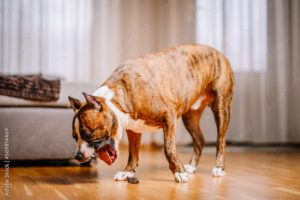Keeping your dog’s teeth clean is crucial for their overall health and well-being. Just like humans, dogs can suffer from dental problems like plaque, tartar buildup, and gum disease if their teeth aren’t properly cared for. Regular brushing is ideal, but not all dogs cooperate with this routine. This is where dog dental treats come in!
Dog dental treats can be a delicious and effective way to help promote your dog’s dental health. By incorporating these treats into your dog’s routine, you can help scrape away plaque and tartar buildup, freshen their breath, and massage their gums, all while keeping them happy and engaged.
However, not all dog treats are created equal. While some may offer a temporary distraction, they might not provide the necessary dental benefits. Here’s where consulting your veterinarian and choosing vet-approved dog dental treats comes into play.
This comprehensive guide dives into the world of vet-approved dog dental treats. We’ll explore the benefits of dental treats, delve into the different types available, and provide you with key considerations for choosing the right treats for your pup. We’ll also share some information on homemade options, with veterinarian guidance of course!
Benefits of Dog Dental Treats
Dental treats offer several advantages for your dog’s oral health:
- Plaque and Tartar Removal: The chewing action of certain dental treats helps scrape away plaque and tartar buildup on your dog’s teeth. This can help prevent gum disease and other dental problems.
- Freshen Breath: Many dental treats contain ingredients that help freshen your dog’s breath, combating bad doggy breath.
- Gum Massage: The act of chewing on dental treats can massage your dog’s gums, promoting healthy blood flow and potentially reducing the risk of gum disease.
- Mental Stimulation: Dental treats can provide your dog with mental stimulation, keeping them occupied and potentially reducing boredom-related chewing behaviors.
Types of Dog Dental Treats
There are several types of dog dental treats available, each with its own benefits and drawbacks:
- Dental Chews: These are typically long-lasting chews designed to be gnawed on for extended periods. The chewing action helps scrape away plaque and tartar buildup. Examples include nylon chews, bully sticks, and rawhide chews (use caution with rawhide and choose high-quality options).
- Dental Biscuits: These harder treats are designed to be crunched on, promoting mechanical cleaning of the teeth. They come in various shapes and sizes and may contain ingredients that freshen breath.
- Dental Sprays and Gels: These are applied directly to your dog’s teeth and gums. They often contain enzymes that can help break down plaque and freshen breath.
- Dental Wipes: These wipes can be used to wipe your dog’s teeth and gums, removing debris and freshening breath.
Choosing the Right Dog Dental Treats for Your Pup
When choosing dog dental treats, consider the following factors:
- Your Dog’s Age and Chewing Habits: Puppies need softer treats, while adult dogs can handle harder chews. Consider your dog’s chewing habits; aggressive chewers may need tougher options to prevent them from swallowing large pieces.
- The VOHC Seal: Look for treats with the VOHC (Veterinary Oral Health Council) seal of approval. This indicates that the treat has been tested and proven effective in reducing plaque and tartar buildup.
- Ingredients: Avoid treats with high sugar content or artificial ingredients. Look for treats made with natural ingredients that are safe for dogs.
- Size and Shape: Choose treats that are appropriate for your dog’s size to prevent them from choking on large pieces.
- Dental Needs: If your dog has specific dental issues, consult your veterinarian for recommendations on the most suitable treats.
Can You Make Homemade Dog Dental Treats?
While commercially available vet-approved treats are a great option, you can also explore homemade alternatives with your veterinarian’s guidance. Here are some considerations:
- Safety: Only use dog-safe ingredients. Avoid ingredients like grapes, raisins, xylitol, and onions, which are toxic to dogs.
- Effectiveness: The homemade treat should have a texture that encourages chewing and scraping of teeth.
- Veterinarian Consultation: Discuss your plans for homemade treats with your veterinarian to ensure they are safe and effective for your dog’s specific needs.
Simple Homemade Dental Treat Recipe (with Veterinarian Approval)
Ingredients:
- 1 cup mashed sweet potato (cooked and cooled)
- 1/2 cup rolled oats (quick oats work best for senior dogs or dogs with dental issues)
- 1/4 cup unsweetened applesauce
- 1/4 cup shredded coconut (unsweetened)
Instructions:
- Preheat oven to 300°F (150°C). Line a baking sheet with parchment paper.
- In a large bowl, combine mashed sweet potato, rolled oats, applesauce, and shredded coconut. Mix well until a dough forms.
- If the dough feels too dry, add a tablespoon or two of water to achieve a manageable consistency.
- Roll out the dough onto a lightly floured surface to a thickness of about 1/2 inch.
- Use a knife or cookie cutter to cut the dough into desired shapes. Bone shapes are a fun option!
- Place treats on the prepared baking sheet and bake for 20-25 minutes, or until golden brown and firm to the touch.
- Let the treats cool completely before serving to your dog.
Important Note: This recipe is provided for informational purposes only. Always consult with your veterinarian before giving your dog any homemade treats, including this one, to ensure they are safe and appropriate for your dog’s specific needs and dietary restrictions.
Additional Tips for Promoting Your Dog’s Dental Health
- Regular Brushing: The gold standard for dental care is regular brushing with a dog-specific toothbrush and toothpaste. Aim to brush your dog’s teeth at least a few times per week.
- Dental Checkups: Schedule regular dental checkups with your veterinarian for professional cleaning and to address any potential dental problems early on.
- Dental Toys: Provide your dog with dental toys in addition to treats. These toys can help massage their gums and scrape away plaque buildup.
Conclusion
By incorporating a combination of dental treats, regular brushing, dental checkups, and dental toys into your dog’s routine, you can significantly contribute to their overall dental health. Remember, a healthy mouth is a happy mouth, and a happy mouth leads to a happier and healthier pup!
At Truffle Paws, we’re here to simplify this process for you. Our goal is to select the best insurance plan for your dog that keeps your dog healthy and ensures you’re ready for the financial responsibilities. Let’s connect today and protect your dog.







